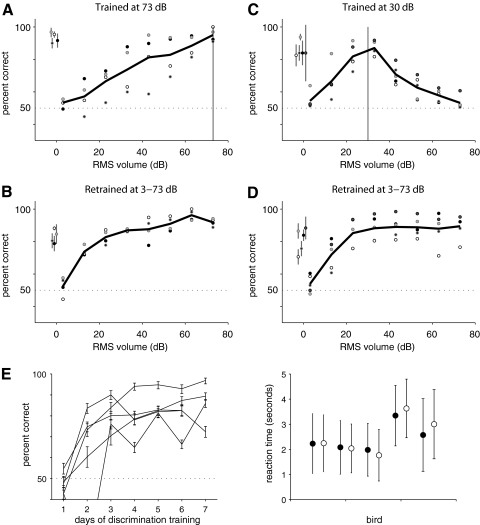Fig. 6.
Testing generalization from one volume to another. A: performance of 4 birds trained at 73 dB RMS on probe songs played at 3–73 dB. Birds did not consistently generalize across volumes: 1 bird performed significantly worse than its control behavior for all tested stimuli softer than 73 dB, whereas another performed significantly worse for stimuli below 63 dB. Two other birds showed a small amount of generalization, but performed significantly worse than control for stimuli softer than 43 and 33 dB, respectively. B: performance of the same 4 birds after retraining on stimuli played at 3–73 dB. Performance at low volumes (13–43 dB) improved for all birds, indicating that their initial generalization performance at these intensities was not as good as the birds' ability to discriminate these stimuli. C: performance of 5 birds trained with 30 dB RMS songs on probe songs at 3–73 dB. The birds performed significantly above chance for songs from 13–43 dB but performed at chance level for songs played at 63 and 73 dB. The vertical line in (A) and (C) indicate the RMS volume of the training songs. D: performance of the same birds in (C) on identical probes after 1–2 days of retraining with songs at many volumes. All symbols as in (Fig. 3C). After retraining, the birds performed above chance for all songs between 13 and 73 dB. These data indicate that failure to correctly classify loud songs in C was not due to an inability to discriminate them. E, left: Learning curves for 5 naive birds trained to discriminate songs of two different individuals played at 30 dB RMS. Mean ± SD of percent correct are shown for each day. All birds learned to discriminate better than chance by the 3rd day of training. Right: Mean and SD of reaction times for birds trained on 30 dB songs.

